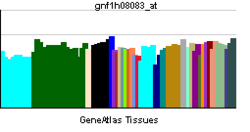KCNH5
| View/Edit Human | View/Edit Mouse |
Potassium voltage-gated channel, subfamily H (eag-related), member 5, also known as KCNH5, is a human gene encoding the Kv10.2 protein.[5]
Voltage-gated potassium (Kv) channels represent the most complex class of voltage-gated ion channels from both functional and structural standpoints. Their diverse functions include regulating neurotransmitter release, heart rate, insulin secretion, neuronal excitability, epithelial electrolyte transport, smooth muscle contraction, and cell volume. This gene encodes a member of the potassium channel, voltage-gated, subfamily H. This member is a pore-forming (alpha) subunit of a voltage-gated non-inactivating delayed rectifier potassium channel. This gene is not expressed in differentiating myoblasts. Alternative splicing results in three transcript variants encoding distinct isoforms.[5]
Mutations in this gene have been linked to cases of early onset Epilepsy.(10.1111/epi.12201)
References
- ↑ "Diseases that are genetically associated with KCNH5 view/edit references on wikidata".
- ↑ "Drugs that physically interact with Potassium voltage-gated channel subfamily H member 5 view/edit references on wikidata".
- ↑ "Human PubMed Reference:".
- ↑ "Mouse PubMed Reference:".
- 1 2 "Entrez Gene: KCNH5 potassium voltage-gated channel, subfamily H (eag-related), member 5".
Further reading
- Gutman GA, Chandy KG, Grissmer S, et al. (2006). "International Union of Pharmacology. LIII. Nomenclature and molecular relationships of voltage-gated potassium channels.". Pharmacol. Rev. 57 (4): 473–508. doi:10.1124/pr.57.4.10. PMID 16382104.
- Occhiodoro T, Bernheim L, Liu JH, et al. (1998). "Cloning of a human ether-a-go-go potassium channel expressed in myoblasts at the onset of fusion.". FEBS Lett. 434 (1-2): 177–82. doi:10.1016/S0014-5793(98)00973-9. PMID 9738473.
- Volorio S, Simon G, Repetto M, et al. (1999). "Sequencing analysis of forty-eight human image cDNA clones similar to Drosophila mutant protein.". DNA Seq. 9 (5-6): 307–15. doi:10.3109/10425179809008469. PMID 10524757.
- Schönherr R, Gessner G, Löber K, Heinemann SH (2002). "Functional distinction of human EAG1 and EAG2 potassium channels.". FEBS Lett. 514 (2-3): 204–8. doi:10.1016/S0014-5793(02)02365-7. PMID 11943152.
- Ju M, Wray D (2002). "Molecular identification and characterisation of the human eag2 potassium channel.". FEBS Lett. 524 (1-3): 204–10. doi:10.1016/S0014-5793(02)03055-7. PMID 12135768.
- Strausberg RL, Feingold EA, Grouse LH, et al. (2003). "Generation and initial analysis of more than 15,000 full-length human and mouse cDNA sequences.". Proc. Natl. Acad. Sci. U.S.A. 99 (26): 16899–903. doi:10.1073/pnas.242603899. PMC 139241
 . PMID 12477932.
. PMID 12477932. - Ota T, Suzuki Y, Nishikawa T, et al. (2004). "Complete sequencing and characterization of 21,243 full-length human cDNAs.". Nat. Genet. 36 (1): 40–5. doi:10.1038/ng1285. PMID 14702039.
- Gerhard DS, Wagner L, Feingold EA, et al. (2004). "The status, quality, and expansion of the NIH full-length cDNA project: the Mammalian Gene Collection (MGC).". Genome Res. 14 (10B): 2121–7. doi:10.1101/gr.2596504. PMC 528928
 . PMID 15489334.
. PMID 15489334. - Otsuki T, Ota T, Nishikawa T, et al. (2007). "Signal sequence and keyword trap in silico for selection of full-length human cDNAs encoding secretion or membrane proteins from oligo-capped cDNA libraries.". DNA Res. 12 (2): 117–26. doi:10.1093/dnares/12.2.117. PMID 16303743.


